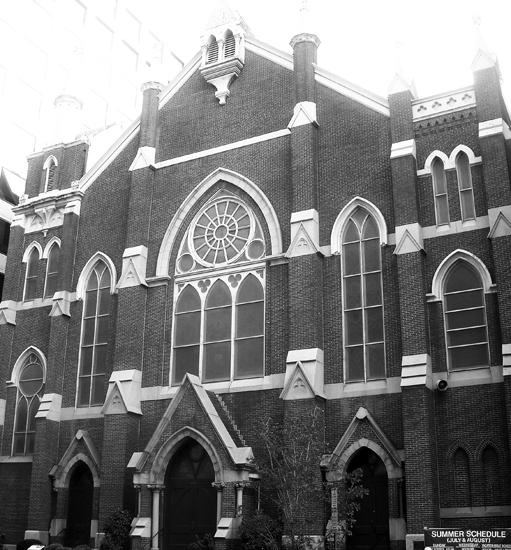The Purgatorial Restoration of the City’s Flagship AME Church
By • July 26, 2011 0 1158

The Metropolitan African Methodist Episcopal Church (AME) at 1518 M St. appeared recently on the National Trust for Historic Preservation’s list of the country’s 11 most endangered historic places, and on the D.C. Preservation League’s annual list of the most endangered places in Washington. Founded in 1838, the structure stands as a significant piece of cultural and architectural heritage, a bastion of advocacy for human rights.
From anti-slavery leadership in the mid-19th century, to fighting on the front lines for civil rights, to AIDS education and voter registration projects today, Metropolitan AME Church not only been a major center of worship, but also an institution in the forefront of the civic, cultural, and intellectual life of African Americans. In 1895 it hosted the funeral for Frederick Douglass, a regular attendee, and in 2005 held the memorial service for Rosa Parks.
The red brick Victorian Gothic-style church was constructed exclusively by donations from AME congregations across the country. Their goal was to establish a permanent presence near the White House and U.S. Capitol in order to pressure the federal government for equal treatment of the African American community.
Walled in on three sides by recent development projects, the church has suffered numerous structural cracks resulting from vibrations during adjacent construction. The congregation has been a responsible steward, funded major repairs over the years to maintain the building and has begun a restoration drive. However, previously unknown, ongoing water infiltration has caused more extensive damage. Over the years, the 29 stained glass windows have been compromised due to deteriorated lead jointing, the grand staircase and sanctuary floors have settled, and inadequate internal gutters have caused water damage to the walls and ceiling. The building urgently requires a multi-million-dollar rescue effort, an investment that Metropolitan AME Church’s community of dedicated supporters simply cannot afford.
And while the U.S. government and District BIDs have been manically funneling its resources into a kaleidoscope of potentially unstable city programs and distributing grants in attempts to defibrillate the economy — the blind faith in the success of electric cars comes to mind, despite almost a century’s worth of evidence to the contrary — they sometimes neglect the true strength of communities. In history and unity lies strength, and by neglecting the foundations of our country’s past as it deteriorates beneath infinite parking garages and office buildings of the big businesses that tanked the financial sector in the first place (which are in themselves on the life support of government loans), we are only further impeding the recovery of our local communities.
This is probably nothing that will go noticed in the short term, nor will the detriment ever be precisely quantifiable. But without the surrounding culture and the history of fighting for human rights, for freedom, a fight that Metropolitan AME Church has stood for since its foundation, Washington as a city has little to stand for at all. The health of a richly historic community in the nation’s capital is surely worth the price of one building’s renovation. While Metropolitan AME hosts patron-dependent “Historic Restoration and Preservation Crab Feasts” at $55 a ticket, one wonders who could step in and lend a hand.

